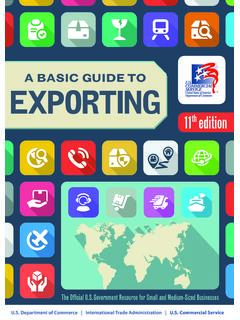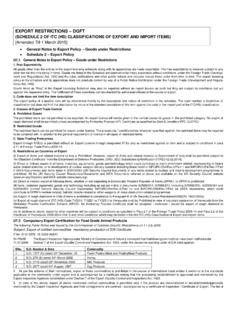Transcription of The Korean Wave: Cultural Export and Implications
1 The Korean Wave: Cultural Export and Implications Brian Truong HIST484: Globalization Capstone Dr. Tauger Spring 2014 Truong 2 Globalization has allowed for South Korea s economy to blossom over the past 30 years to lift it out of poverty and turn it into an Asian Tiger economy. In addition to having well-known technological products and heavy industry, South Korea has transformed its modern pop culture for Export , known as the Korean Wave. The Korean film industry, music industry and online gaming have become very popular in many Asian countries, and its popularity has spread to other continents as well. The term hallyu coined by the Taiwanese press for the Korean wave defined it as the Korean [cold] spell , which best describes its feverish surge in popularity over the last 15 The Korean Wave is also summarized as K-pop by their fans when referring to South Korea s pop Although this Export was only meant to be temporary relief from the 1997 Financial Crisis, the Korean Wave would grow to be South Korea s major contribution to globalized culture.
2 South Korea continues to use hallyu as a way to spread its culture abroad and improve its international reputation. The Korean Wave is rooted in the liberalization of Korean culture in the late 1980s through early 1990s. Social and economic reforms by president Kim Young Sam in the early 1990s threw off the old military regime in favor of popular freedom at home, a diplomatic style of foreign policy and economic New social and economic freedoms gave the Korean entertainment industry more artistic capabilities that were previously restricted under past military regimes. South Korea opened up to 1 Hong Chan-sik,. " Korean Wave backlash in Taiwan." Dong-A, January 02, 2012.
3 (accessed March 31, 2014). 2 Doobo Shim. "Hybridity and the rise of Korean popular culture in Asia." Media, Culture & Society. no. 25 (2006): 25-44. (accessed March 2, 2014). 3 Takuji Katawa, and Yoshiharu Asano. "1994 a big year for South Korea's Kim." The Daily Yomiuri, February 24, 1994. (accessed March 29, 2014). Truong 3 globalization and developed tastes for pop culture during this A liberalization of culture allowed for experimental music and cinema to emerge with a new generation of Korean entertainers. However, the liberalization of economic policies strained the economy to the point of near collapse in the 1997 Financial Crisis. South Korean society was forced away from a stringent conservative society; as a US investment banker put it at the time of the crisis, [South Korea] will need a Cultural revolution to survive.
4 5 Decades of industrialization and prosperity were halted so suddenly that most Koreans panicked and struggled to adapt to the new economic landscape. Previously, white-collar jobs at big corporations were seen as a ticket to job security. The economic collapse forced Koreans to forgo their rigid Confucian class structure and take lower paying jobs when many were laid off. The foundations of the Korean Wave are found in this panic when South Korea was forced to thoroughly reevaluate its existing corporate culture. In response, Koreans gave their own culture more value and shifted away from manufacturers The abandonment of rigid corporate culture was linked to sustainable modernization that would encourage creativity and entrepreneurism.
5 Small business owners during the economic transition such as Kim Hyoung Hawn felt that Korean society was headed in the wrong direction [..] this is a healthy correction. 7 This revival of Korean culture 4 Jae-cheol Moon. "The Meaning of Newness in Korean Cinema: Korean New Wave and After." Korea Journal 46, no. 1 (Spring2006 2006): 36-59. Academic Search Complete, EBSCO host (accessed April 7, 2014). 5 John Burton. "A wounded tiger reluctant to change its stripes: John Burton explains the Cultural barriers to economic reform in crisis-torn South Korea." Financial Times, November 29, 1997. (accessed March 30, 2014). 6 Jonghoe Yang. "The Korean Wave (Hallyu ) in East Asia: A Comparison of Chinese, Japanese, and Taiwanese Audiences Who Watch Korean TV Dramas.
6 " Development and Society. no. 1 (2012): 103-147. (accessed March 30, 2014). 7 Donald Macintyre. "Korea Thinks Small." Time, April 19, 1999. ,33009,990777-2, (accessed April 19, 2014). Truong 4 allowed for South Korea to develop its own modern culture that was unique from anything that was available in Japan or the West. Differentiating its own culture made Korean pop culture a competitor to other industrialized societies in East Asia. Although Korean culture borrowed some aspects of Western and Japanese pop culture, it was able to forge its own identity as a result of economic crisis. In addition to being an economic Export , the Korean Wave was also meant to preserve Korean culture from the demands of the International Monetary Fund s bailout.
7 The IMF bailout forced South Korea to liberalize imports from Japan after the 1997 Financial Crisis, raising colonial-era fears that the Japanese would flood its products and Cultural onto South Korean These fears never materialized or had much effect on Korean society, but led Korea s Cultural Ministry to invest heavily on its entertainment industry. A large array of Cultural technology departments were created in South Korea, with 300 departments formed that offered programs and scholarships to eligible These departments were established at existing South Korean universities to tailor its own pop culture for Export . The Ministry emphasized Cultural Export as a primary aspect of economic development. Even in the early days of the Korean Wave, efforts were made to make South Korean culture an international product.
8 In 1999, the two popular pop groups SES and performed alongside Michael Jackson at a charity concert in Seoul that was broadcasted throughout Asia. Both groups were selected by Korea s largest ad company Cheil Communcations due to their 8 John Burton. "South Korea to end Japanese import ban." Financial Times, June 30, 1999. (accessed April 7, 2014). 9 Norimitsu Onishi. "South Korea adds culture to its Export power." June 29, 2005. (accessed May 1, 2014). Truong 5 potential [..] to launch themselves into the international ranks of top popstars. 10 The global promotion of Korean pop culture was an intentional effort led by the Korean Cultural Ministry and Korean entertainment companies to Export programming.
9 South Korea s music industry flourished amidst the crisis. Many of South Korea s most popular pop performing artists emerged during these years. The pop dance groups SES and were formed in 1997 and were extremely popular with teenage Korean youth when they first began performing. s first album High Five of Teenagers sold a record million Their performance was known for its style of dance music that was about love and compassion. Korean pop music groups centered on large dance groups that acted as performers in addition to singers, captivating their audience with complex dancing routines. This style of performance would set the template for the future of K-pop that distinguished it from other modern pop cultures.
10 The style of music was distinct to anything found in the modernized world and was uniquely Korean . K-pop industry capitalized on these images for their domestic tween demographic, marketing everything from perfumes for teens and beverages in ways similar to the marketing of Western pop artists The ability to market these pop artists outside of music sales transformed K-pop into a versatile lifestyle product. The success of the Korean Wave also helped revitalize other aspects of the entertainment industry that were affected by the economic crisis such as cable TV. MTV s partnership with South Korean music channel helped tailor MTV 10 Kortim. and to Star with Michael Jackson.













